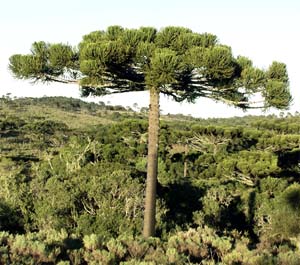Araucaria angustifolia Information
Identification:
An evergreen tree growing to 40 m tall and 1 m trunk diameter. The leaves are thick, tough and scale like, triangular, 3-6 cm long, 5-10 mm broad at the base, and with razor-sharp edges and tip. They persist for 10–15 years, so cover most of the tree except for the trunk and older branches.
General Information:
Araucaria angustifolia is closely related to Araucaria araucana from further southwest in South America, differing most conspicuously in the narrower leaves. It grows to similar sizes as A. araucana but with a much more spreading crown, often forming a flattened canopy crown. It prefers well drained, slightly acidic soil but will tolerate almost any soil type provided drainage is good. It requires a subtropical climate with abundant rainfall, tolerating occasional frosts down to about -5°C to -8°C. It is the iconic living fossil. A prehistoric tree dating back to the late Triassic period 210 million years ago and had a world-wide spread (both hemispheres) in the Jurassic (205-145 million years BP) and Cretaceous (145-65 million years BP) periods. The tree’s armoury of sharp leaves is probably an evolutionary adaptation to protect it from browsing dinosaurs. The distribution of the Araucariaceae contracted at the end of the Cretaceous during the extinction of the dinosaurs (c. 65 million years BP) when the family became extinct in the northern hemisphere.
Distribution:
Native to, Argentina, Brazil, Paraguay
It is native to southern Brazil (sometimes found in high-altitude areas of southern Minas Gerais, southern Rio de Janeiro and Sao Paulo, but more typically in the states of Parana, Santa Catarina and Rio Grande do Sul; locally in Paraguay (Alto Parana) and the northeast of Argentina (Misiones and Corrientes), growing in low mountains at altitudes of 500-1800 meters. The Araucaria moist forests have a subtropical highland climate, with frequent frosts during the winter months and some snowfalls (generally light) in the highest areas. Annual precipitation is high, ranging from 1,300-3,000 millimetres (51-120 in), without a dry season.
Location: Brazil (-24.744171°N, -51.855469°E)
Observations
Araucaria angustifolia Overlay Image ©2025 Trebrown - No re-distribution without permission.

